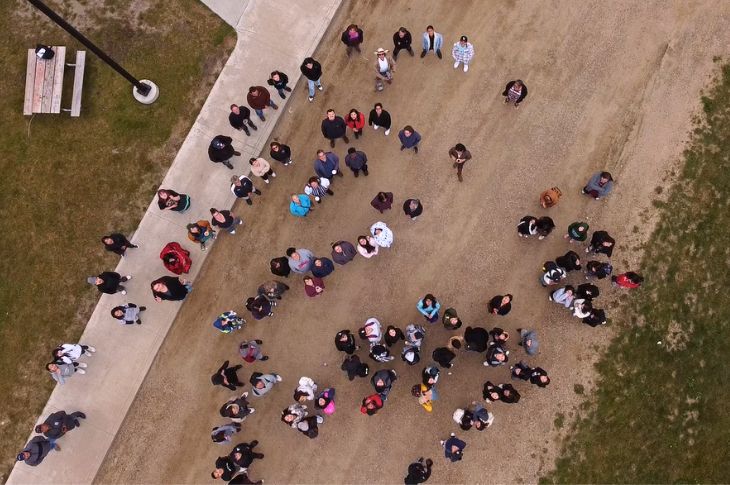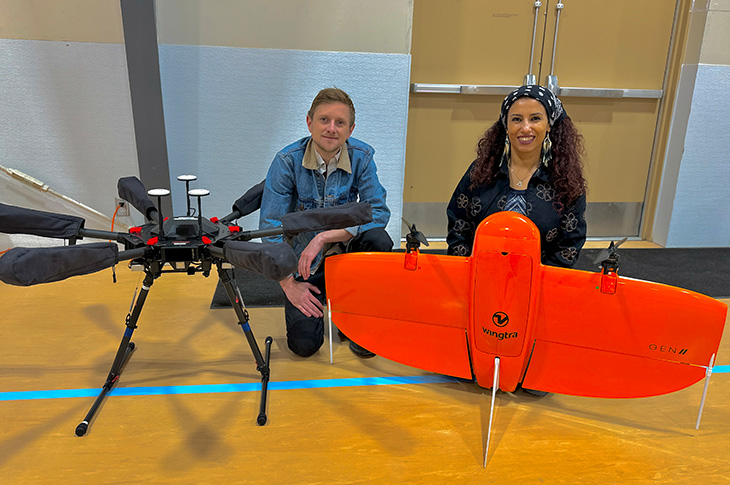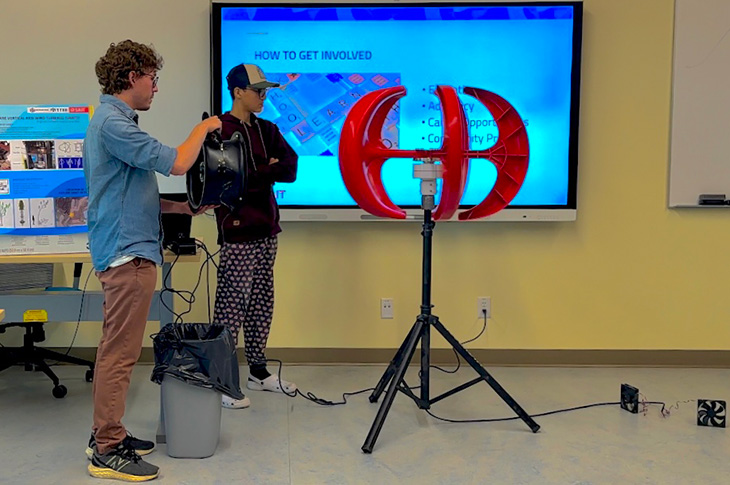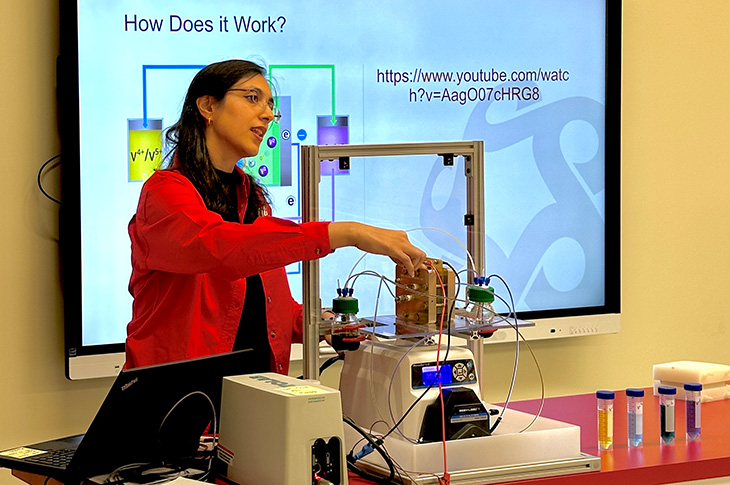Looking towards innovation at Science Cultural Camp in Frog Lake First Nation

How heavy is a drone used for GIS mapping? When it’s part of a camp with experts (and their tech!) from SAIT’s Applied Research and Innovation Services (ARIS), students can learn the answer just by picking it up.
The two-day science cultural camp brought research impacting their community to life for more than 60 students at Frog Lake Tus-Tuk-EE-SKAWS High School. They explored technology used in projects with Frog Lake First Nation, such as mapping with drones, net-zero housing designs, large-scale batteries for renewable energy and small-scale wind turbines.
"The Science Cultural Camp, facilitated by our dedicated team at the ARIS hub, was ignited by a passion for interdisciplinary science and environmental awareness among the participants,” says Jamie McInnis, ARIS Hub Director. "It combined scientific knowledge with cultural heritage, fostering a deeper connection for all participants.”
The projects were developed through an ongoing research partnership to create solutions that address immediate and long-term sustainability goals for the community. They aligned to the cultural value that the land is stewarded with respect, sustainability and balance, which is seen through priorities like energy sustainability and wildfire mitigation.
Experiences like this two-day camp at Frog Lake Tus-Tuk-EE-SKAWS High School are an opportunity for education and awareness, which helps bridge the gap to clean energy science for the benefit of the next seven generations,” says Ay’den Abraham, Green Energy Youth Coordinator for Frog Lake First Nation.
Community projects + science cultural camp = innovation
Remotely piloted aviation systems technology

These days, it seems like there’s always a map when you need it — but they do come from somewhere.
Community project: Remotely piloted aviation systems — or advanced drones — are used to create a detailed 3D model and map of the area for the Frog Lake Drone Survey project. It will help with future mapping, the development of a geodatabase, and ensuring the community’s drones are safe and registered.
⛺ Taking it to camp: SAIT’s drone experts, Nicolas Hunter and Sara Ashoori from the Centre for Innovation and Research in Unmanned Systems (CIRUS), talked to the group about how to operate drones and prepare for each mission. The live demo showcased the drones’ capabilities and real-world applications, plus there were a few smaller machines for students to do their own test flight.
Surrounded by a crowd of students, Nicholas Hunter, CIRUS Research Technologist, fielded lots of questions.
“It was fantastic to see the students had such a high level of engagement with the technology. One student, who had clearly played a lot of video games, had piloting skills near my level — he was professional and smart with it.
“Some students were really trepidatious to fly the little drones, but they challenged themselves and worked through it. It was really cool to see, just about everyone gave it a go.”
Net-zero home construction

Countless materials are combined when building a home, but what designs will work best in a specific region? That’s something Frog Lake First Nation and ARIS are investigating with the Net-zero Home Construction project.
💡Community project: To address housing challenges, the project was initiated to create two community-driven housing designs that embrace net-zero principles for emissions and energy efficiency. The homes will be durable, built with readily available materials, and easy to maintain by residents and local professionals.
⛺ Taking it to camp: Matthew Stachniak from the Green Building Technology Access Centre shared net-zero housing principles, like those used in the two initial designs with the Frog Lake First Nations community. One of the major areas in buildings for energy loss is windows, but how much of a difference do they really make? Stachniak brought a light box with several types of windows, so students could feel for themselves how different windows can affect temperatures inside a home.
Wind turbine technology

Renewable energy is the subject of accelerated innovation, but have you ever seen a wind turbine that can fit in a classroom?
💡Community project: ARIS is working with the community to find innovative energy solutions, including small-scale Vertical Axis Wind Turbines (VAWT) that can fit in smaller areas. Unlike traditional wind turbines, VAWTs have a compact design perfect for populated areas, enabling decentralized energy generation. This project will pair a commercial VAWT with a large-scale battery (the next project in this series) to provide backup power at Frog Lake Tus-Tuk-EE-SKAWS High School.
⛺ Taking it to camp: Tyler Willson from Green Building Technology Access Centre brought a small wind turbine into the classroom to show students a live demonstration of how VAWTs generate energy and how that might integrate with an energy storage system.
Vanadium redox flow battery

We spend all day with all kinds of batteries in our devices, but what about a battery that can store enough renewable energy to provide backup power to a school?
💡Community project: Imagine a battery that’s not only flexible and durable but also incredibly safe — though you won’t be carrying it in your pocket. The Vanadium Redox Flow Battery (VRFB) stores energy in liquid form, making it perfect for large-scale energy storage. Because renewable energy sources like solar and wind can be unpredictable, VRFBs ensure a consistent energy supply by capturing excess energy during peak times and releasing it when production dips.
⛺ Taking it to camp: Maedeh Pahlevaninezhad and Marlon Norona from the Centre for Energy Research and Clean Unconventional Technology Solutions ran a live demonstration of a 20 kW battery to show students the science behind it. This small-scale model will soon be deployed to the community, showcasing its real-world potential.
Browse our photo gallery on Facebook
Industry driven — industry driver
SAIT's Applied Research and Innovation Services (ARIS) team develops new or improved technologies in response to the innovation needs of industry.
Partner with ARISIndustry Driven
We prepare students for successful careers and lives.
SAIT'S
2020-2025
Strategic plan

Oki, Âba wathtech, Danit'ada, Tawnshi, Hello.
SAIT is located on the traditional territories of the Niitsitapi (Blackfoot) and the people of Treaty 7 which includes the Siksika, the Piikani, the Kainai, the Tsuut’ina and the Îyârhe Nakoda of Bearspaw, Chiniki and Goodstoney.
We are situated in an area the Blackfoot tribes traditionally called Moh’kinsstis, where the Bow River meets the Elbow River. We now call it the city of Calgary, which is also home to the Métis Nation of Alberta.